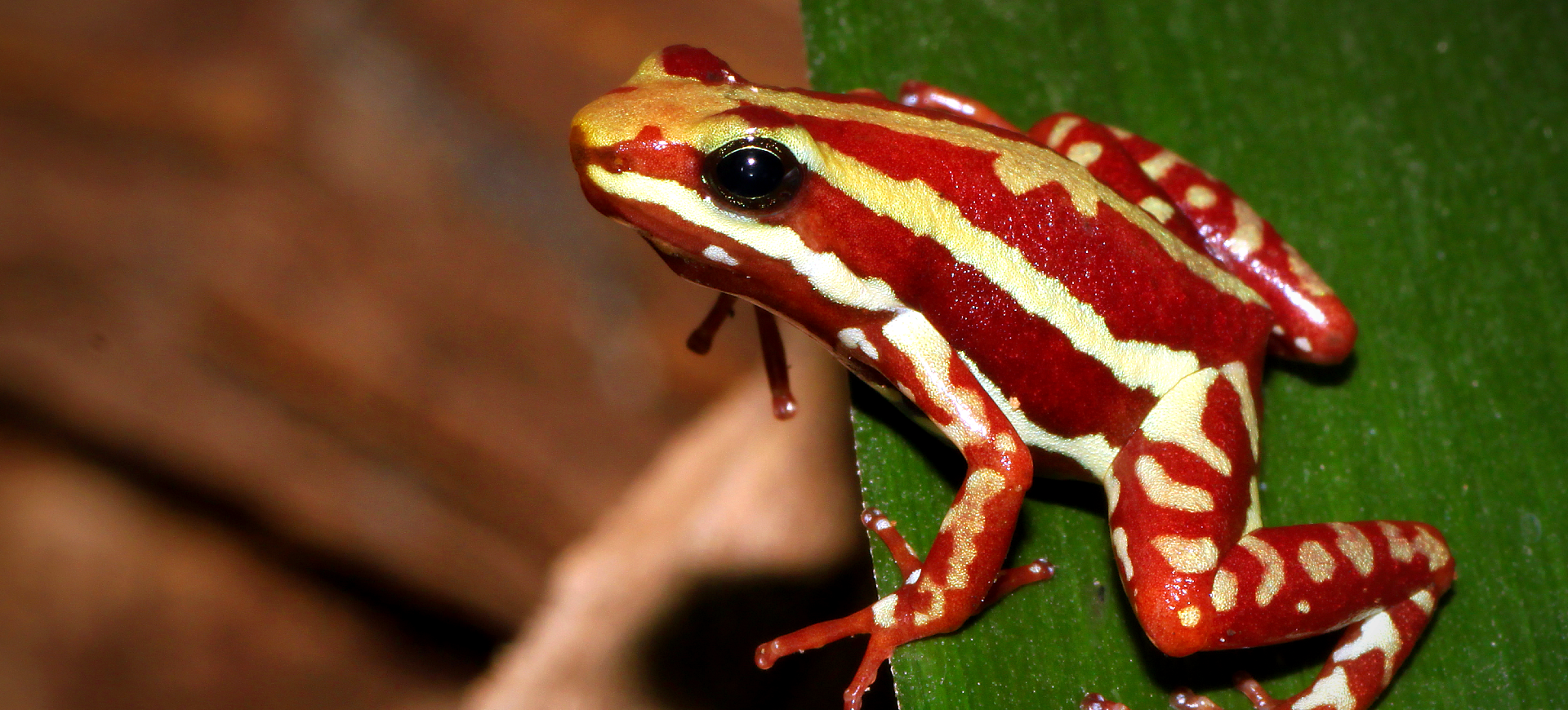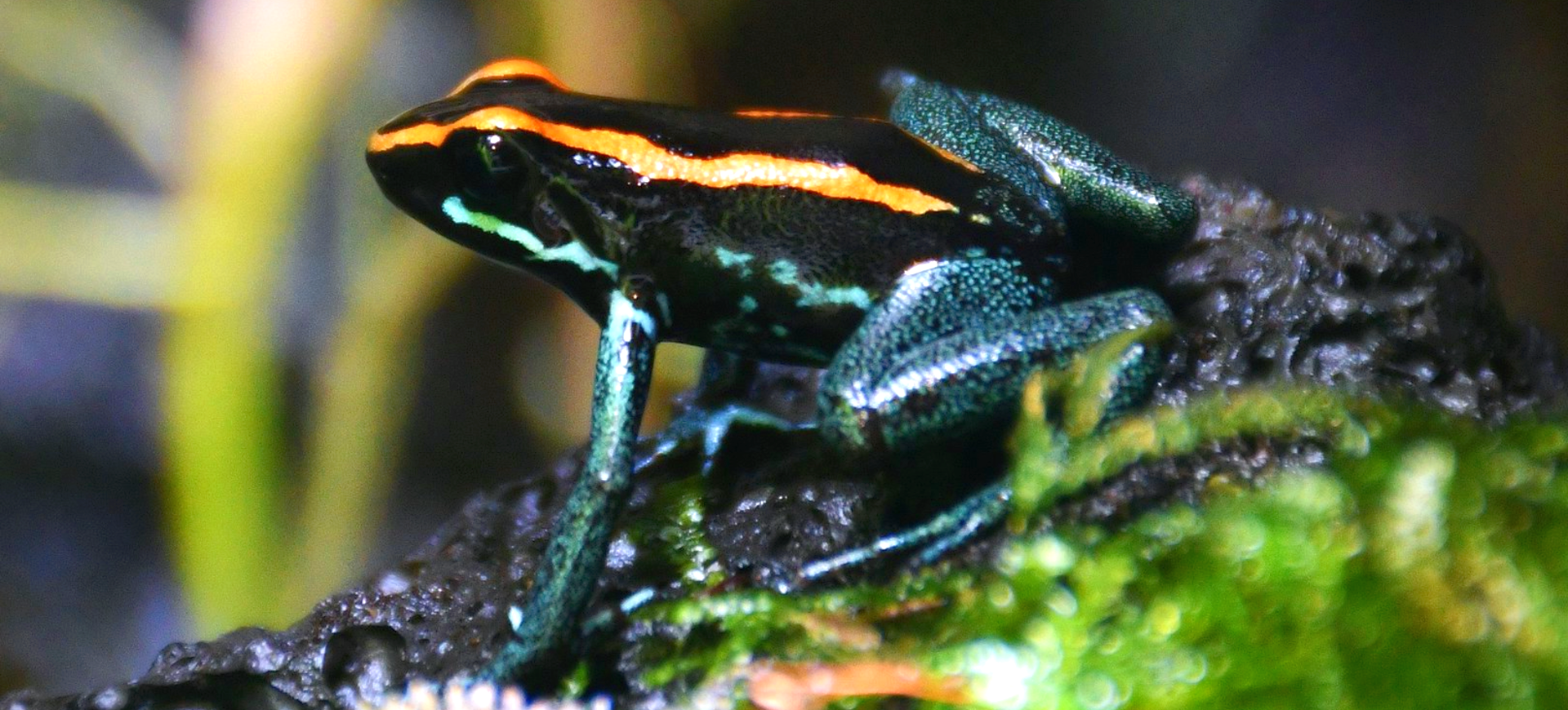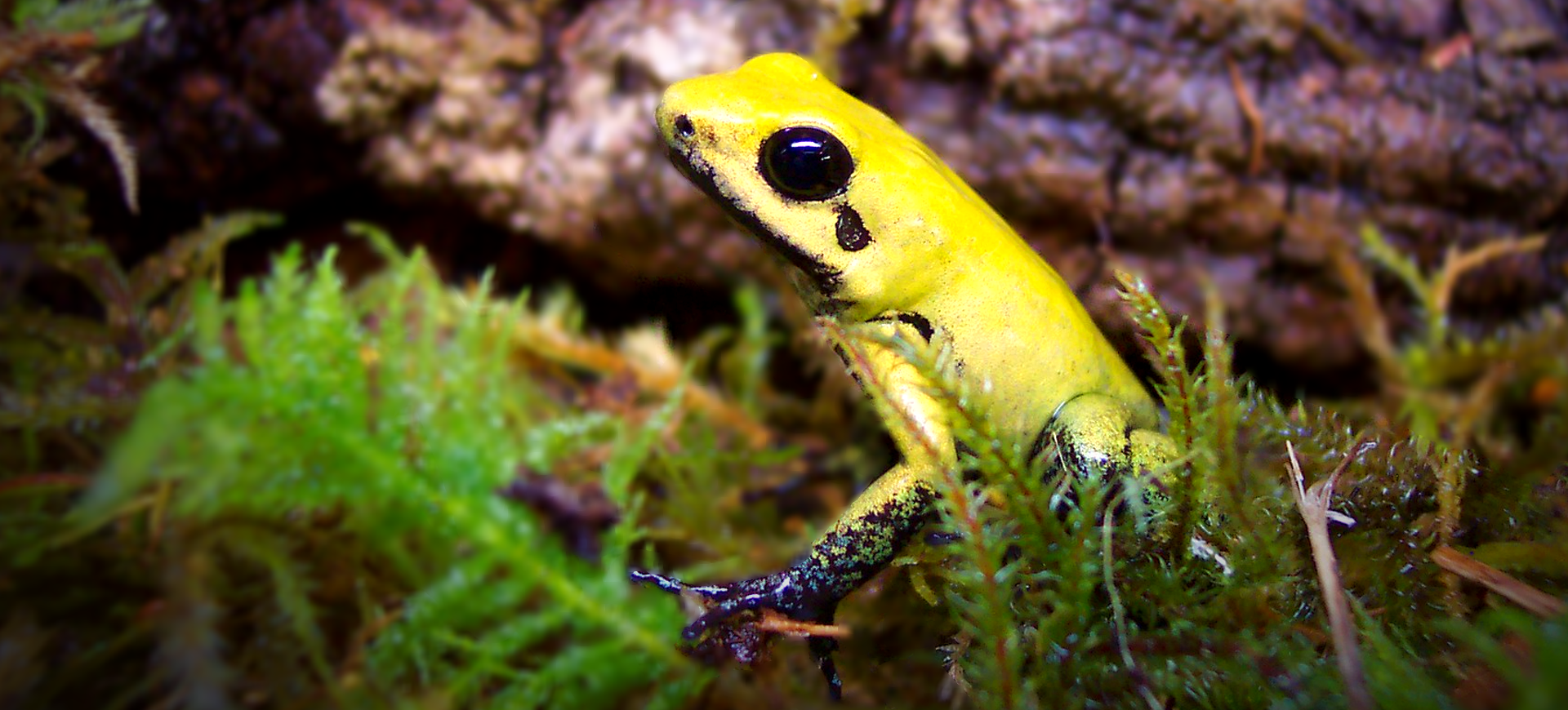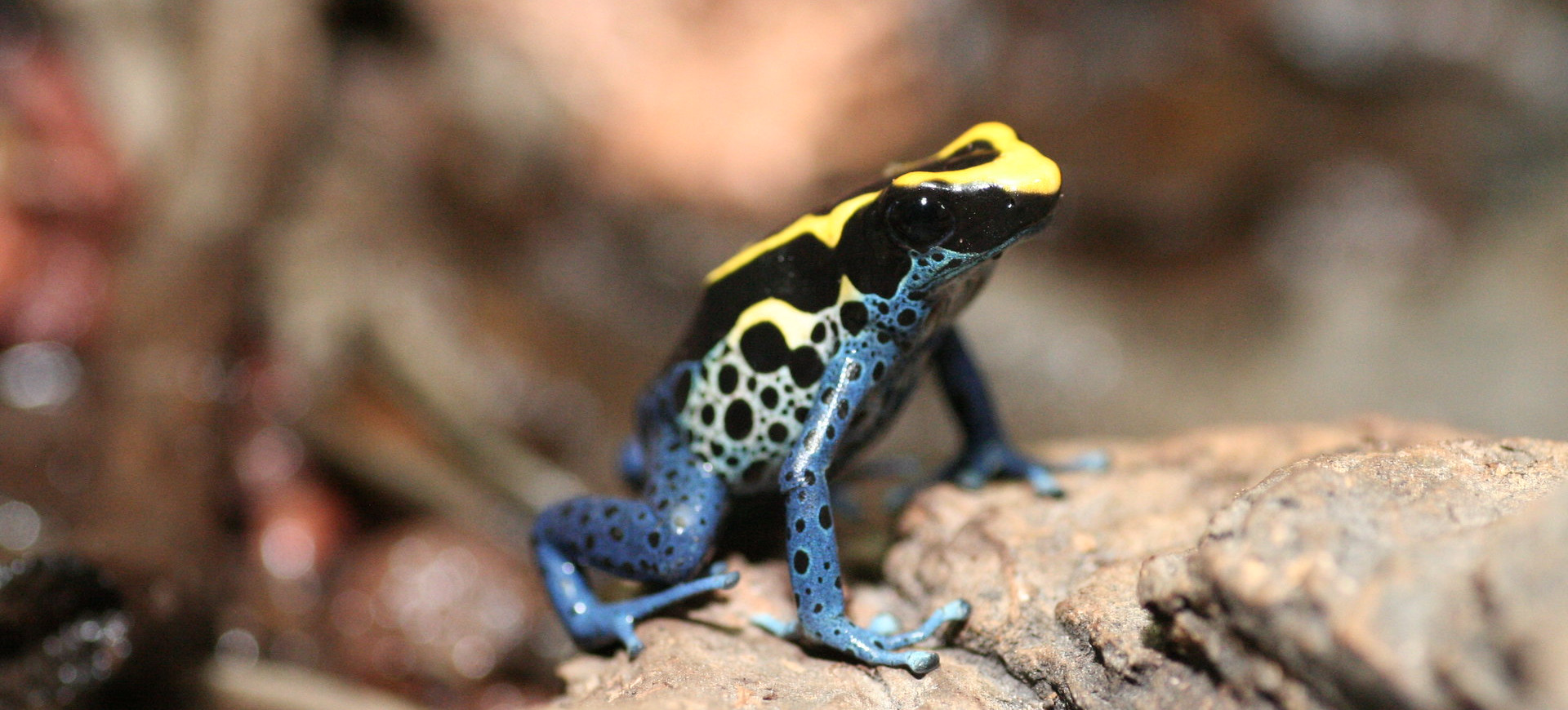Overview
The Green and Black Poison Dart Frog, scientifically known as Dendrobates auratus, is a vibrant and striking amphibian known for its distinctive green and black marbled pattern. This small frog, typically ranging from 1 to 2 inches in length, is not only admired for its vivid coloration but also for its potent toxin, which it produces through its skin as a defense mechanism against predators. Native to Central America and parts of South America, these frogs thrive in humid, tropical environments where they can be found in the understory layer of rainforests, often near streams and water bodies. The bright coloration of Dendrobates auratus serves as a warning to potential predators about its toxicity, a phenomenon known as aposematism.
In the wild, the diet of the Green and Black Poison Dart Frog consists primarily of small insects and arthropods, including ants, beetles, and mites. This diet is crucial for the synthesis of their skin toxins, with the variety and quantity of prey influencing the toxicity of individual frogs. These amphibians are diurnal, meaning they are active during the day, which is relatively unusual for frogs. Their daily activities include foraging for food, calling to attract mates, and defending their territory from rivals. The frogs’ small size and distinctive call make them a fascinating subject of study for herpetologists and nature enthusiasts alike.
The reproductive behavior of Dendrobates auratus is notable for its complexity and the care provided to offspring. Males are territorial and will call to attract females to their chosen nesting sites. After mating, the female lays her eggs in moist leaf litter, where the male then guards and tends to the eggs, keeping them moist until they hatch. Upon hatching, the tadpoles are carried on the backs of their parents to water-filled bromeliads or other small bodies of water, where they will complete their development into froglets. This level of parental care is relatively rare among amphibians and highlights the unique life history of the Green and Black Poison Dart Frog.
Taxonomy
Kingdom
Phylum
Class
Order
Family
Genus
Species
Type
RANGE
Current distribution:
Dendrobates auratus is distributed throughout Central America, extending from Costa Rica through Panama and into parts of South America, including Colombia. This distribution encompasses a variety of rainforest habitats, from lowland areas to foothills, where they find the moist, warm conditions they require. Despite this broad range, the populations of Green and Black Poison Dart Frogs are fragmented, often isolated in patches of suitable habitat surrounded by areas of human development or agriculture.
Conservation efforts are focused on protecting these habitats and connecting isolated populations through ecological corridors. The frogs' presence in many protected areas helps safeguard them from the worst human impacts, but threats from deforestation, pollution, and the illegal pet trade persist. Efforts to monitor populations and habitat health are crucial for ensuring the long-term viability of Dendrobates auratus in the wild, alongside initiatives to raise awareness and promote sustainable land use practices.
Physical Description:
The Green and Black Poison Dart Frog is renowned for its stunning green and black marbled appearance, which varies significantly across its range, with some individuals appearing more green and others more black. The skin of these frogs is smooth and glossy, helping to highlight their striking color patterns. Adults typically reach lengths of 1 to 2 inches, making them relatively small compared to other frog species. Their size and coloration are not only important for predator deterrence but also play a role in attracting mates.
Beyond their visual appeal, the physical structure of Dendrobates auratus is adapted for a life spent both in the leaf litter of the forest floor and the trees. They have well-developed legs that allow for strong jumping ability, and adhesive pads on their toes enable them to climb smooth surfaces easily. The variation in color patterns among populations suggests a degree of adaptation to local environments, possibly reflecting differences in predation pressure or habitat. Despite their toxicity, these frogs are preyed upon by certain species of snakes and spiders that have developed resistance to their poison, showcasing the dynamic nature of predator-prey relationships in their ecosystem.

Lifespan: Wild: ~4 Years || Captivity: ~10 Years

Weight: Male & Female: 0.1-0.35 ounces (3-10 g)

Length: Male & Female: 1-2 inches (2.5-5 cm)

Height: Male & Female: 1.25-1.5 inches (3.2-3.8 cm)
Characteristic:
Native Habitat:
The Green and Black Poison Dart Frog is native to the humid, tropical rainforests of Central America and parts of South America, including Costa Rica, Panama, Nicaragua, and parts of Colombia. Their preferred habitat includes lowland forests and areas adjacent to streams and rivers, where humidity is high and temperatures are stable. The dense vegetation and abundant leaf litter provide ample cover and foraging opportunities for these frogs, as well as breeding sites.
The microhabitats within their range, such as bromeliads, leaf litter, and tree holes, play a crucial role in the life cycle of Dendrobates auratus, offering nesting sites and safe havens for tadpoles. The frogs’ reliance on these specific environmental conditions makes them sensitive to habitat destruction and climate change. Conservation of their rainforest habitat is essential for their survival, highlighting the importance of protecting these ecosystems not just for the frogs but for the myriad of species that share their home.
Climate Zones:
Biomes:
WWF Biomes:
Biogeographical Realms:
Continents:
Countries:
Diet:
Diet & Feeding Habits:
The diet of the Green and Black Poison Dart Frog is primarily insectivorous, focusing on small insects and arthropods found in the rainforest understory. Ants, beetles, mites, and other small invertebrates make up the bulk of their diet. These prey items are crucial for the accumulation of alkaloids in the frogs’ skin, which are converted into the toxins that make them poisonous to predators. The frogs use their long, sticky tongues to capture prey, a process that requires precision and speed.
Feeding behavior in Dendrobates auratus is characterized by active hunting during the daylight hours, taking advantage of their daily nature. They rely on their acute vision to spot potential prey, often stalking their targets before making a quick strike. The variety in their diet is thought to contribute to the variation in toxicity among individuals and populations, with those consuming a broader range of alkaloid-rich prey being more toxic. In captivity, these frogs are often fed a diet of fruit flies, pinhead crickets, and other small insects, though this diet does not produce the toxins found in wild frogs.
Mating Description:
The Green and Black Poison Dart Frog exhibits a fascinating reproductive strategy that includes elaborate courtship behaviors and significant parental care. Males are known to be territorial and will vocalize to attract females and deter rivals. Their calls, which can vary in pitch and duration, serve as a means of communication and mate attraction within the dense forest environment. Once a female is attracted, the pair will engage in a series of behaviors that lead to the laying of eggs in a moist, sheltered location, often within leaf litter or in crevices.
After the eggs are laid, the male takes on the responsibility of keeping them moist and protected until they hatch into tadpoles. This may involve transporting water to the eggs in his cloaca or simply ensuring the eggs do not dry out. Upon hatching, one parent, typically the male, will carry the tadpoles on their back to a suitable water-filled location, such as a bromeliad axil, where they will complete their development into froglets. This level of parental investment is relatively rare among amphibians and is a key feature of the reproductive ecology of Dendrobates auratus.
Reproduction Season:
Birth Type:
Pregnancy Duration:
Female Name:
Male Name:
Baby Name:
Social Structure Description:
The Green and Black Poison Dart Frog exhibits a social structure that is somewhat unique among amphibians. While not highly social, these frogs are territorial, with males establishing and defending territories that are used for mating and feeding. The vocalizations made by males play a crucial role in territory defense and mate attraction, serving as a means of communication within their environment. Within their territories, males and females will engage in complex behaviors related to mating, territory defense, and parental care.
The level of parental care provided by Dendrobates auratus, particularly the transport of tadpoles to water sources, is a notable aspect of their social behavior. This care ensures the survival of the offspring in the competitive and predator-rich environment of the rainforest. The frogs’ interactions are primarily focused on reproduction and territory defense, with less emphasis on group dynamics compared to some other social animal species. Understanding the social structure and behaviors of Dendrobates auratus is important for conservation efforts, as it influences habitat requirements and responses to environmental changes.
Groups:
Conservation Status:
Population Trend:
The Green and Black Poison Dart Frog is currently classified as Least Concern by the IUCN Red List, indicating a relatively stable population across its natural range. However, this status does not imply that the species is free from threats; habitat destruction, pollution, and the illegal pet trade pose significant risks to their populations. Conservation efforts are essential to mitigate these threats, focusing on habitat protection, pollution control, and the regulation of trade in wild-caught specimens.
In some regions, populations of Dendrobates auratus have experienced declines due to deforestation and land conversion for agriculture. Conservation programs that include habitat restoration and the establishment of protected areas have been implemented to address these challenges. Education and outreach programs aimed at local communities can also help reduce the impact of human activities on these frogs and their habitats. Ongoing research into the ecology and behavior of Dendrobates auratus is crucial for informing conservation strategies and ensuring the species’ long-term survival.
Population Threats:
The primary threats to the Green and Black Poison Dart Frog include habitat loss due to deforestation, land development, and agriculture. These activities not only reduce the available habitat for the frogs but also fragment populations, making it difficult for individuals to find mates and maintain genetic diversity. Pollution from agricultural runoff and industrial activities further threatens their survival, contaminating the water bodies and leaf litter they depend on for breeding and feeding.
The illegal pet trade also poses a significant risk to Dendrobates auratus, with individuals often captured from the wild for sale in international markets. While captive breeding programs have reduced the demand for wild-caught specimens, illegal collection continues in some areas. Efforts to regulate the pet trade and promote captive breeding can help alleviate the pressure on wild populations. Climate change is an emerging threat, with changes in precipitation patterns and temperature potentially impacting the frogs’ habitat and food sources.
Conservation Efforts:
Conservation efforts for the Green and Black Poison Dart Frog include habitat protection and restoration, the establishment of protected areas, and initiatives to combat the illegal pet trade. Many populations of Dendrobates auratus are located within national parks and reserves, providing a measure of security against habitat destruction and pollution. Conservation organizations and research institutions are working to better understand the species’ ecology and habitat requirements, which is essential for effective conservation planning.
Captive breeding programs play a significant role in conservation, both by providing specimens for the pet trade and reintroduction efforts. These programs also offer opportunities for research into the frogs’ behavior, genetics, and physiology, which can inform conservation strategies. Education and outreach initiatives aimed at local communities and the broader public are crucial for raising awareness about the threats facing Dendrobates auratus and the importance of amphibian conservation. Collaborative efforts between governments, NGOs, and the scientific community are key to the long-term survival of this iconic species.
Additional Resources:
Fun Facts
- Despite their name, Green and Black Poison Dart Frogs are not used to make poison darts by indigenous people; this practice is associated with other species of poison dart frogs.
- The toxins produced by Dendrobates auratus are derived from their diet; captive frogs not fed the same diet as wild frogs do not produce these toxins.
- These frogs have excellent vision, which they rely on to spot prey and navigate through the dense foliage of their rainforest habitat.
- Dendrobates auratus is one of the few amphibian species known to exhibit parental care, with males often playing a significant role in the survival of their offspring.
- The vibrant coloration of these frogs is a classic example of aposematism, where bright colors warn potential predators of the animal’s toxicity.
- Green and Black Poison Dart Frogs can live for over a decade in captivity, longer than many other amphibian species.
- The species is popular in the pet trade due to its striking appearance and relatively easy care requirements in a well-maintained terrarium.
- Research on Dendrobates auratus has contributed to our understanding of chemical ecology, particularly how animals use chemicals derived from their diet for defense.
- The calls of male Green and Black Poison Dart Frogs are unique and can be used to distinguish individuals.
- Conservation efforts for Dendrobates auratus not only protect the frogs but also the rich biodiversity of their rainforest habitats.












